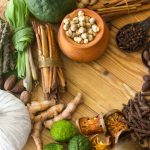- Introduction: Thailand’s Quiet Green Powerhouse
- What Is Moringa? (มะรุม) Roots, Names & Everyday Uses
- The Nutritional Profile: Why This Tree Earned Its Hype
- Moringa Powder Benefits (How the Spoonful Works for You)
- Moringa Tea Benefits (Sip Your Greens, Thai-Style)
- Everyday Use: Simple Ways to Add Moringa to Your Routine
- Safety First: Side Effects & Dosage You Should Know
- Smart Shopping: Quality, Freshness & Storage
- Moringa in Thailand & the Bigger Picture
- Conclusion: A Small Habit with Big Payoff
- ❓ FAQs
Introduction: Thailand’s Quiet Green Powerhouse
Across Thailand, you’ll spot a humble tree shading village yards, its branches hung with long drumstick-like pods and soft, oval leaves. Locals call it มะรุม (marum)—you may know it as moringa. For generations, families have tossed the pods into tangy curries, simmered the leaves in soups, or brewed a gentle teatime infusion. Today, moringa is stepping from traditional kitchens into modern wellness routines—smoothies, capsules, lattes, and nourishing broths—because the plant’s nutrition profile is astonishingly dense for such a modest tree.
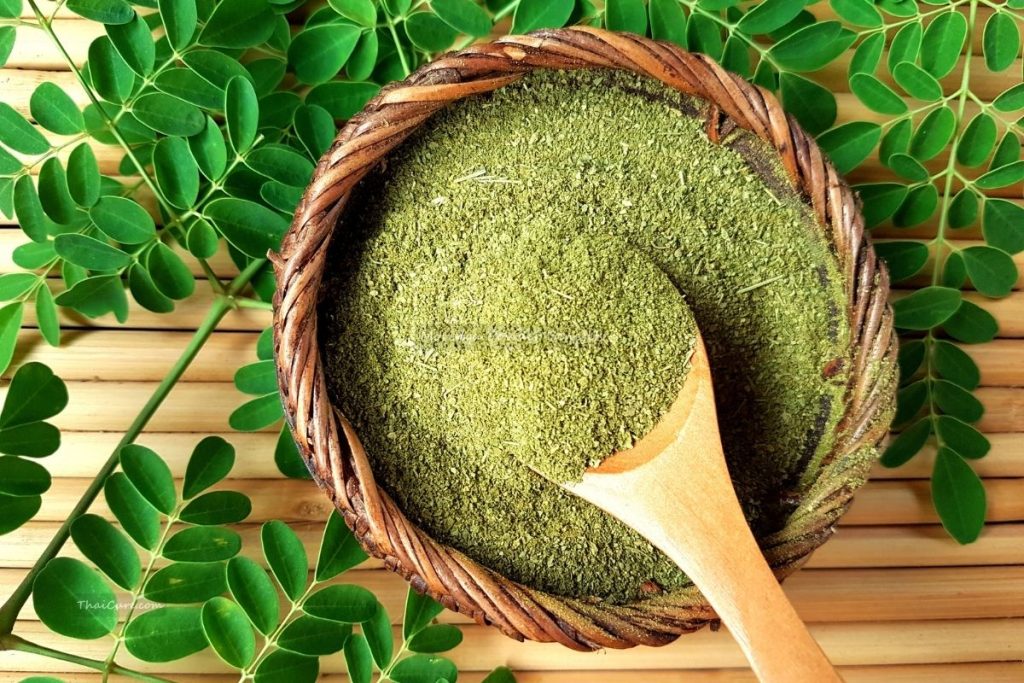
This guide explores the culture and the science—what moringa is, why it’s revered, and practical ways to add it to your day. We’ll spotlight moringa powder benefits in accessible, everyday terms, then compare them with soothing, sip-friendly moringa tea benefits. You’ll also get clear notes on sensible dosage, who should be cautious, and how to shop wisely in Thailand and beyond.
Whether you’re here for energy you can feel, pantry-level convenience, or a connection to Thai foodways, you’ll find something useful. I’ll share how Thai cooks weave moringa into familiar dishes, what textures and flavors to expect, and small rituals that make it easy to keep up the habit. Think of this as your friendly, culturally respectful, and evidence-informed map to a vibrant green staple—approachable enough for beginners, rich enough for wellness lovers.
👉 “Looking to refresh your body and mind? Don’t miss our guide on The Detoxifying Effects of Thai Herbal Teas.”
By the end, you’ll know exactly how to introduce moringa to your routine—one brew, one spoonful, or one cozy bowl at a time—without overcomplicating things or losing the warmth that makes Thai home cooking so special.
What Is Moringa? (มะรุม) Roots, Names & Everyday Uses
Moringa (Moringa oleifera) is a fast-growing, drought-tolerant tree native to South Asia that thrives in tropical climates across Thailand. You can recognize it by its delicate pinnate leaves and long green pods, often nicknamed “drumsticks.” The tree’s reputation comes partly from its “use-nearly-everything” nature: moringa leaves are eaten fresh or dried, the pods are cooked when young and tender, and the seeds yield a light, stable oil. In Thai home cooking, the flavor is gentle—slightly grassy, a touch peppery—playing well with lemongrass, lime, and chilies.
Culturally, moringa belongs as much to weekday kitchens as festival tables. You’ll find it in village soups, clear broths with garlic and fish sauce, or simmered in sour curries that balance tartness and umami with green freshness. In wellness contexts, people dry or powder the leaves for convenience, stirring a small spoonful into water, coconut milk, or fruit blends. Cafés in Bangkok and Chiang Mai are increasingly offering moringa lattes or herbal blends alongside Thai tea and roselle, signaling how traditional herbs are finding modern expression.
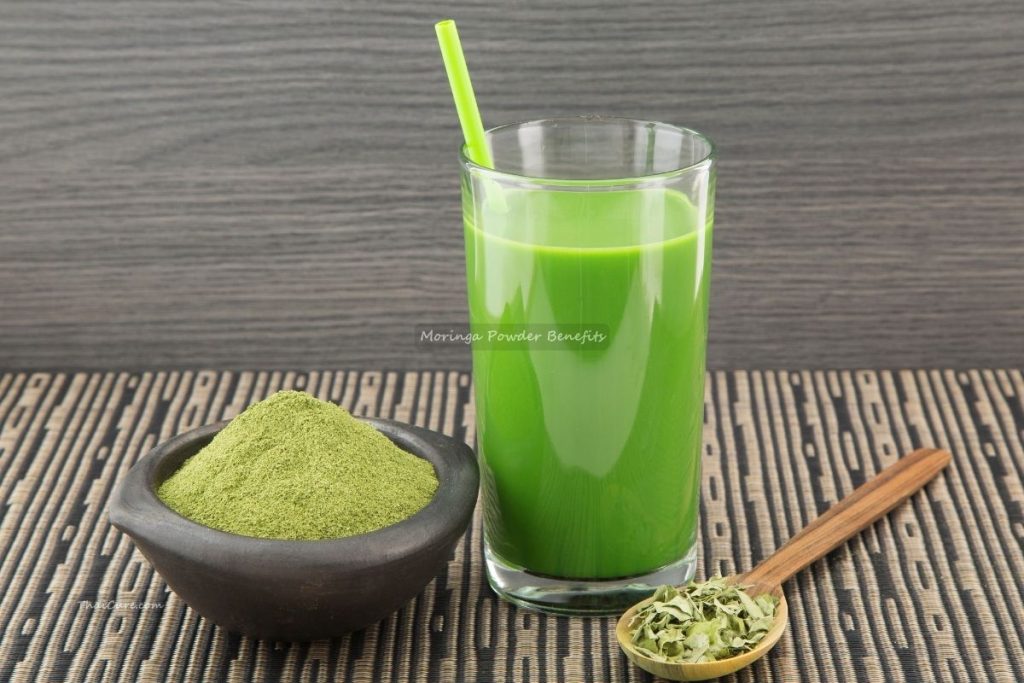
From a nutrition perspective, moringa nutrients stand out. The leaves are rich in vitamins A and C, plus minerals like calcium and iron. They also contain plant compounds that support antioxidant capacity. While “superfood” is a marketing word, it fits here because the tree provides a concentrated set of desirable nutrients with remarkable versatility in the kitchen.
👉 “For more Thai wellness insights, don’t miss our roundup of Turmeric Tea Benefits & Thai Superfoods for Wellness.”
That versatility is why moringa has crossed borders. If you like to cook, you’ll appreciate how easily the leaves wilt into stir-fries or omelets. If you’re busy, you’ll love how a teaspoon of powder can travel from smoothie to soup without fuss. And if you prefer a quiet ritual, a simple infusion—moringa, hot water, a slice of ginger—can become a soothing anchor to your afternoon.
The Nutritional Profile: Why This Tree Earned Its Hype
When you first read about moringa, you’ll likely notice enthusiastic comparisons: “more vitamin A than carrots, more vitamin C than oranges,” and so on. Exact numbers vary by growing conditions and processing, but the broader truth holds—moringa packs a lot into a small serving. A teaspoon of leaf powder can contribute meaningful amounts of vitamins, minerals, and phytonutrients without adding many calories.
What does that mean day to day? For busy families, a pantry jar of powder is a straightforward insurance policy: stir it into congee, whisk into a light soup, or blend into yogurt on rushed mornings. This practicality underlies many moringa powder benefits—a reliable format that doesn’t require elaborate prep or special equipment.
Beyond vitamins and minerals, moringa contains polyphenols and other compounds associated with antioxidant activity. You’ll hear this framed as moringa antioxidants, which reflects the plant’s potential to help your body handle everyday oxidative stress from exercise, pollution, and ordinary metabolism. While “antioxidant” has become a catchall term, in the kitchen it simply means adding colorful, plant-rich ingredients across your week—a strategy where moringa fits beautifully.
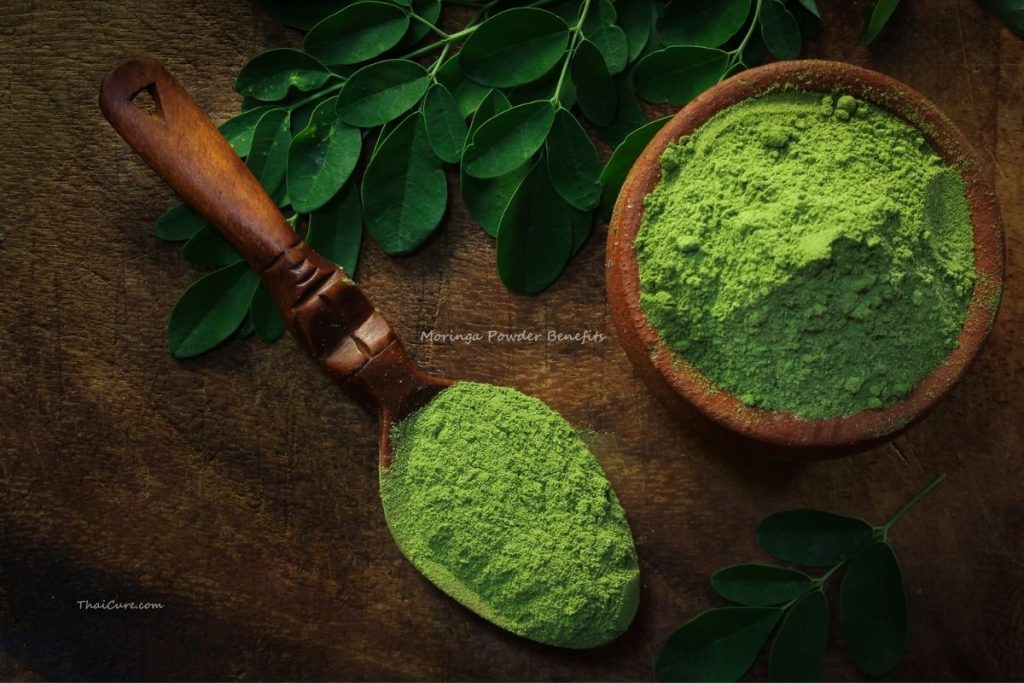
Another phrase you’ll see is anti-inflammatory benefits. Again, the real-world translation is straightforward: many traditional Thai meals already align with patterns associated with balanced eating—plenty of herbs, vegetables, broths, and gentle spices. Using moringa alongside galangal, turmeric, kaffir lime, and leafy greens adds depth to that pattern. None of this turns moringa into a magic bullet, but it does make it an elegant tool for building a nutrient-dense routine rooted in food you’ll actually eat.
Texture and taste matter, too. Powder made from carefully dried leaves tends to be mellow and a shade of olive green. If it smells fresh and slightly grassy, you’re in good hands; if the aroma is dull or musty, it may have been stored poorly or over-heated during drying. The fresher the powder, the easier it is to love in simple recipes—thin soups, coconut-milk curries, or even a splash into pandan-scented rice porridge.
Finally, keep practicality in mind. If your household includes kids or elders, consistent small servings beat big, occasional doses. A half-teaspoon added to a midday soup might be more enjoyable—and more sustainable—than an ambitious smoothie you dread making.
Moringa Powder Benefits (How the Spoonful Works for You)
Moringa Powder Benefits
At the heart of modern home use is convenience: stable on the shelf, easy to measure, and friendly to both savory and sweet dishes. Among the everyday moringa powder benefits people notice first is how effortlessly it slips into existing habits. If you already make a banana-spinach smoothie, a measured pinch of moringa disappears into the flavor, adding a green nudge without demanding a recipe change.
Energy and focus through better basics. It’s common to reach for coffee when afternoon energy dips. A re-framed approach is to start by improving the nutrient density of meals, which is where moringa powder benefits can quietly accumulate—more vitamins A and C, and supportive minerals like iron and calcium—especially on days when vegetables are scarce.
Balanced routine support. Some readers ask about moringa for weight loss. While no single food melts fat, moringa’s fiber and “green” flavor profile can support meals that are higher in vegetables and lean proteins. A soup or stir-fry rounded out with herbs and a pinch of powder may help you feel satisfied with fewer hyper-sweet snacks between meals—simple, sustainable, and aligned with Thai cooking patterns.
Metabolic nudges. Another common question is moringa for diabetes. Here the best approach is cautious: think “food foundation” first. Building balanced plates—vegetables, protein, gentle starch portions—while adding modest amounts of moringa may complement your routine. Always speak with a healthcare professional for personal guidance, especially if you monitor blood sugar or take medications.
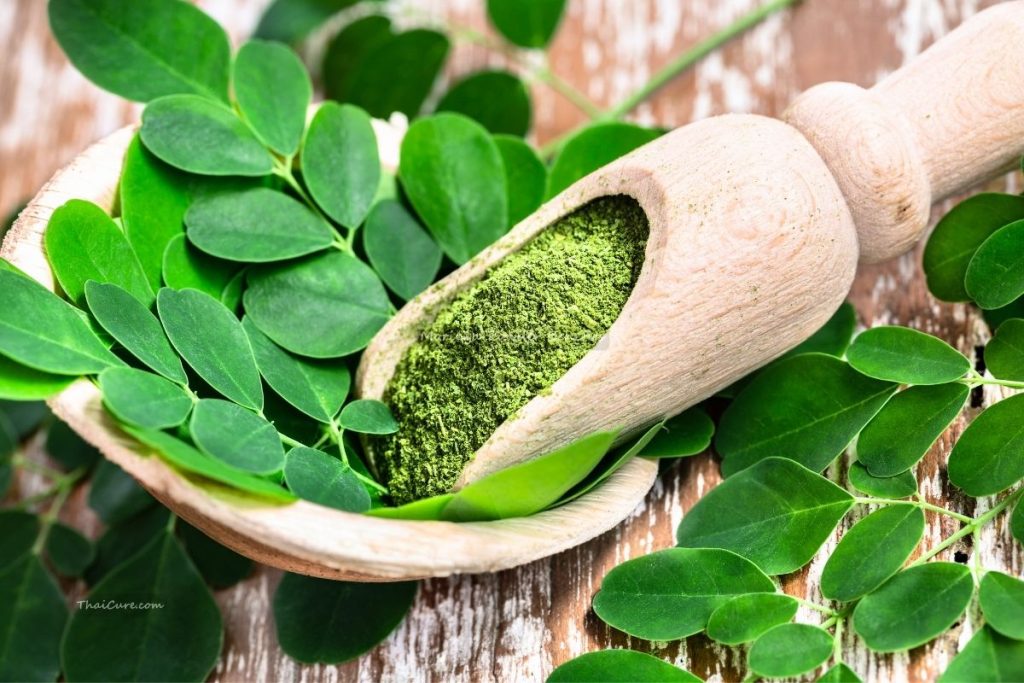
Practical dosing. For many adults, starting small is wise—about ½ teaspoon once a day—then adjusting as you observe tolerance and taste. Mentioning moringa dosage in recipes encourages consistency without overthinking: add a pinch to broth, another to a weekend smoothie. You don’t have to chase perfection; you just need a pattern that fits your life.
Cooking notes. Heat can soften flavor; bright acids (lime juice) and aromatics (garlic, ginger) balance the green. In Thai dishes, moringa pairs well with light fish sauce, white pepper, and tender vegetables, making it at home in both clear broths and coconut-milk curries.
Sensitivity check. If you have existing conditions or take medications, especially for blood sugar or blood pressure, loop in your clinician. Food and herbs can interact positively or negatively; context matters.
In short, moringa powder is a flexible kitchen ally—less a “hack” than a habit—that supports nutrient-dense, satisfying meals you’ll want to repeat.
Moringa Tea Benefits (Sip Your Greens, Thai-Style)
Moringa Tea Benefits
If you prefer rituals to recipes, a cup of tea may fit better than a blender. One of the welcome moringa tea benefits is gentleness: hot water, a few minutes of steeping, and a grassy, refreshing cup you can enjoy plain or with ginger and honey. In Thai households, herbal teas punctuate the day—after lunch to refresh, or in the evening to unwind—making moringa an easy fit.
Another of the practical moringa tea benefits is how adaptable it is to climate. In Thailand’s heat, a cooled infusion over ice with a squeeze of lime is bright and hydrating; in cooler weather, a warm mug is grounding. The lighter flavor profile helps beginners ease into moringa without the “green” intensity that powders can bring to thicker smoothies.
From a nutrition lens, tea contributes hydration plus a modest infusion of plant compounds associated with moringa antioxidants. Keep expectations measured: a tea is naturally lighter than a spoonful of powder, but the ritual anchors your day. It’s perfect for people who want a sustaining habit without extra calories or complicated prep, and it plays nicely with other Thai herbal sips like pandan or lemongrass.
Brewing tips. Use hot but not violently boiling water, and start with two to three grams of dried leaf per cup. Steep three to five minutes, taste, and adjust. Fresh leaves—briefly wilted—can make a delicately sweet brew. Add a slice of ginger for warmth or a hint of kaffir lime leaf for a distinctly Thai perfume.
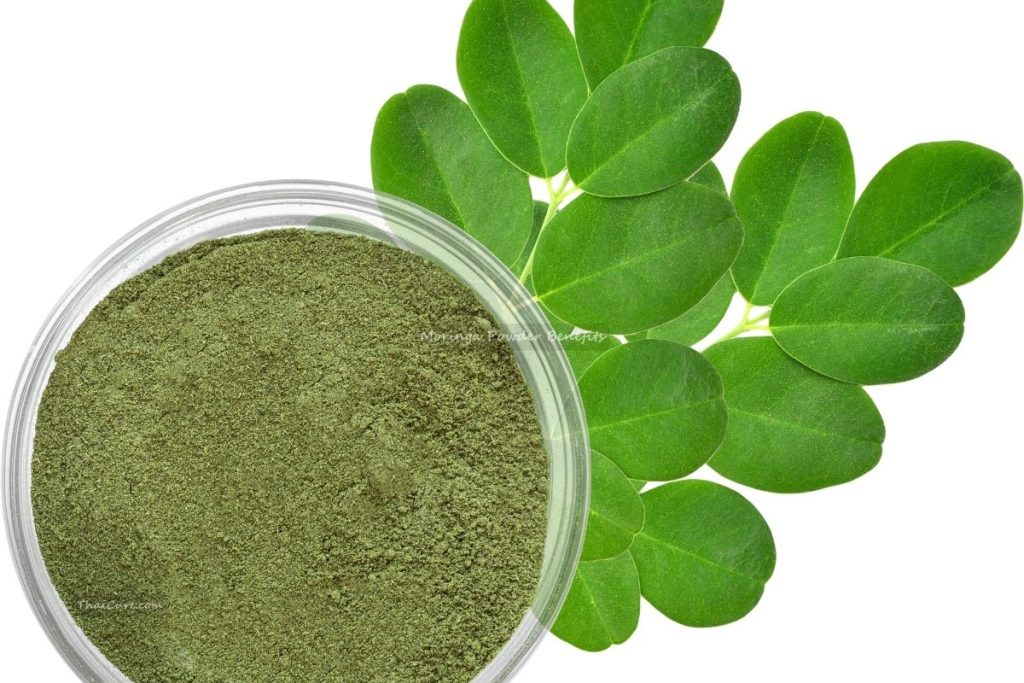
Pairing ideas. Tea pairs beautifully with snacks that don’t overwhelm it—ripe papaya wedges, a small sticky-rice bite, or sesame crackers. If you’re transitioning from sugary drinks, try a lightly sweetened version at first and gradually reduce the sweetener.
If you already love green tea or Thai herbal infusions, this is an easy addition. If you’re new to herbal teas, consider keeping a small jar at your desk; a late-afternoon cup can become a steadying signal to slow down—your mini-ceremony in a busy day.
Everyday Use: Simple Ways to Add Moringa to Your Routine
Think of moringa like salt, pepper, or chili flakes: it’s easier to use consistently when it’s visible and within reach. Keep powder in a cool, dry spot near your stove with a dedicated ½-teaspoon scoop. That tiny ritual—scoop, sprinkle, put away—turns good intentions into action.
Breakfasts
- Stir a pinch into warm congee with white pepper, spring onion, and a drizzle of sesame oil.
- Whisk into an egg omelet with garlic chives and tomatoes.
- Blend into a banana-pineapple smoothie; lime juice keeps flavors bright.
Lunches
- Add to a light chicken broth with mushrooms and bok choy.
- Toss with rice vermicelli, herbs, and shredded chicken for a cool noodle salad.
- Fold into a coconut-milk soup alongside lemongrass and galangal for a gentle green lift.
Dinners
- Simmer young moringa pods with pumpkin in a sour curry (kaeng som) for tang and texture.
- Finish a stir-fry with a small spoonful off the heat to preserve aroma.
- Mix a dash into a yogurt-lime sauce for grilled fish or tofu.
Snacks & sips
- Brew a simple afternoon infusion and serve over ice with lime.
- Sprinkle a whisper of powder over sliced mango with chili-salt for a playful sweet-savory bite.
- Stir into pandan rice pudding while it cools to keep flavors mellow and color luminous.
For families, designate a “green add-ins” basket that lives next to your spices—moringa powder, toasted sesame seeds, roasted peanuts, and seaweed flakes. When toppings are visible, variety becomes automatic. For children, start with tiny amounts and keep the language positive: “a sprinkle of green for strong bodies.” If a recipe turns out too grassy, rescue it with acidity (lime) or aromatics (ginger, garlic), or simply halve the amount next time. Small, repeatable steps are how habits stick.
Finally, be kind to your palate. Some days you’ll crave bold, spicy plates; other days, gentle soups. Moringa plays well with both. The key is to keep it accessible and let it flex with your mood.
Safety First: Side Effects & Dosage You Should Know
Food first, caution always. Most healthy adults tolerate moderate amounts of leaf powder or tea, especially when introduced gradually. Still, clarity matters. People often ask about moringa dosage; a sensible starting point is ½ teaspoon of powder per day, then increase to 1 teaspoon as taste and tolerance allow, pausing if you notice digestive discomfort.
Equally common is the question of moringa side effects. Leaf preparations are generally well tolerated, but taking too much too fast can lead to mild bloating or changes in bowel habits. Very large amounts aren’t better; they’re just harder on your system. If you’re pregnant, breastfeeding, managing chronic conditions, or taking any prescription medications, discuss moringa with your healthcare provider before using it regularly.
Medications and interactions deserve attention. Because moringa may influence appetite and meal composition, people monitoring blood sugar should introduce it thoughtfully. If you’re on medications, keep a simple log when you begin—what you ate, how you felt, any unusual symptoms—and share it at your next check-in. That’s smart practice for any new herb or supplement.
Children and elders can enjoy small amounts folded into familiar dishes. Prioritize taste acceptance over dose: a pleasant soup that gets eaten is better than a “perfect” smoothie no one finishes.
Finally, a note on mindset: herbs support patterns; they don’t replace them. Sleeping enough, staying hydrated, moving your body, and eating a variety of vegetables will do more than any single ingredient. Moringa shines when it complements those basics.
Summary: Start small, be consistent, and aim for comfort over intensity. That approach helps you dial in moringa dosage that fits your life while minimizing potential moringa side effects.
Smart Shopping: Quality, Freshness & Storage
Good moringa starts with good leaves and gentle drying. Look for powder that’s vibrant green with a clean, grassy aroma; avoid dull brown or yellowish hues. Choose brands that specify leaf-only content (not stems), careful drying temperatures, and airtight packaging. In Thailand, check herb shops, weekend markets, and trusted online sellers with clear harvest and processing notes.
If you’re buying loose leaf for tea, inspect the pieces: they should look like intact flakes rather than dusty powder. Ask vendors how they dry and store their herbs; shade-drying and low-heat processing help preserve flavor. Once home, keep your moringa in a cool cupboard away from light and humidity. Use a dedicated dry spoon and close the lid tightly every time—simple kitchen habits that preserve freshness.
Consider origin and relationships. Small producers who handle the whole journey—growing, drying, and packing—often deliver better flavor and consistency. If you find a supplier whose product smells fresh and tastes clean, stick with them; relationships are a very Thai way of ensuring quality over time.
Lastly, buy amounts you’ll actually finish in two to three months. Smaller, more frequent purchases beat a big bag that fades before you use it up. Your taste buds—and your recipes—will thank you.
Moringa in Thailand & the Bigger Picture
Thailand’s culinary landscape is rich with greens, herbs, and aromatics. Moringa fits seamlessly among them, sharing space with sweet basil, holy basil, young tamarind leaves, and morning glory. As more cafés, wellness studios, and home cooks explore herbal traditions, moringa has found a second home in modern formats—barista-style drinks, smoothie bowls, and even confections that use its green hue as a visual signature.
This evolution mirrors a global interest in ingredients that are nutrient-dense, versatile, and rooted in cultural foodways rather than isolated extracts. Thai producers are responding with better drying methods, improved packaging, and clearer labeling. For home cooks, that means a more consistent experience—fresh aroma, pleasant color, and predictable flavor—no matter where you live.
If you’re building a wellness-oriented pantry, moringa pairs naturally with Thai staples like jasmine rice, fish sauce, dried shrimp, limes, and chilies. It can also extend the reach of leftovers: a quick broth, a handful of greens, and a ½-teaspoon of powder turns last night’s rice into a new, satisfying bowl. The point isn’t to chase trends; it’s to honor delicious, workable habits you’ll keep.
In short, moringa is both timeless and timely—anchored in Thai kitchens for generations and well suited to the way many of us want to eat now: simple, flavorful, and nourishing.
Conclusion: A Small Habit with Big Payoff
When a food earns a reputation over centuries, it’s worth a closer look. Moringa’s appeal comes from practicality as much as tradition: a tree that grows easily, a leaf that tastes friendly, and a powder or tea that slides into ordinary meals. If you’ve read this far, you know the core: build your week around real food, then add small, reliable boosts.
Start with what feels natural. If you love soups and stir-fries, put the powder near your stove; let it become part of your mise en place. If you adore quiet rituals, brew a daily cup and lean into the calm. With steady use, moringa powder benefits emerge not as a headline but as an ongoing, supportive background. And for those who prefer to sip their greens, the gentle rhythm of moringa tea benefits can anchor your afternoon or evening.
Taste widely, adjust gently, and favor enjoyment over rules. That’s the Thai kitchen way: abundant herbs, balanced flavors, and meals that leave you feeling light and satisfied. Moringa belongs beautifully in that story—one sprinkle, one sip, one comforting bowl at a time.
❓ FAQs
1. What are the main moringa powder benefits?
Moringa powder is rich in vitamins A and C, iron, calcium, and protein. Regular use may support energy, digestion, and immunity, making it a versatile Thai superfood.
2. What are the top moringa tea benefits?
Drinking moringa tea provides gentle hydration, antioxidants, and relaxation. Thai households enjoy it hot or iced, often with lime or ginger for added flavor and wellness.
3. How much moringa should I take daily (moringa dosage)?
Start with ½ teaspoon of moringa powder per day, then gradually increase to 1 teaspoon. For tea, 2–3 grams of dried leaves steeped 3–5 minutes is ideal.
4. Are there any moringa side effects?
Moringa is generally safe, but too much may cause mild digestive issues. Pregnant or breastfeeding women, and those on medication, should consult a healthcare professional.
5. Can moringa help with weight loss or diabetes?
Moringa supports balanced meals and satiety, which may aid weight control. Some studies suggest moringa helps regulate blood sugar, but it should complement—not replace—medical advice.



